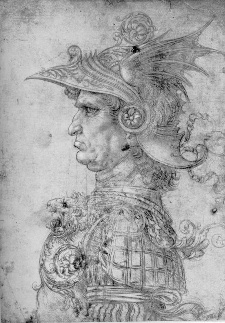(1452-1519)
|
Leonardo da Vinci
(1452-1519) |
Leonardo was essentially a draftsman who at intervals produced a rare but unforgettable painted masterpiece. The Mona Lisa, The Last Supper and The Virgin of the Rocks are too familiar to need further discussions. But Leonardo's drawings cannot be excluded. In style they are they are among the most delicately sensitive ever made, in subject matter they reflect every aspect of Leonardo's enquiring and inventive mind. For most artists the world they live in is a stimulus to creation; their first task is to interpret their experience. For Leonardo the world was primarily a stimulus to a nagging intellectual curiosity that gave rise to drawings fo the anatomical structure of men and animals, designs for machinery and engines of war (including prototypes of modern tanks and heavier-tha-air flying machines)., studies of the movement of water, botanical and geological structure, town planning and architecture.
Such drawings, fascinating as they are to the student of the history of scientific development, are works of art only in the sense that they are the productions of superlative draftsman as well as reflections of a restless, questioning mind. But among them are drawings of other kinds in which Leonardo momentarily forgets the attempt to unravel the mysteries of nature and becomes an artist of a very unusual kind. These are indeed works of art. Some of them are highly finished drawings of the fall of drapery, or portrait heads and hands. Some are experiments in composition connected with known pictures or planned statues. The remainder, in many ways the most precious of all, reveal a romantic mind obsessed by fantasies of various kinds - monsters unknown to man, allegories whose meaning cannot be resolved, intricate modes of hairdressing, costumes (doubtless connected with court pageants in Milan) and, most mysterious of all, a series of drawings that seem to represent progressive stages in some apocalyptic upheaval of the earth. Here and there one comes across exquisite drawings that can only be described a doodles - the uneasy expression of subconscious impulses. Some of these are merely ingenious, sometimes they are fantastically beautiful in their rhythms, sometimes obsessional as though some constantly recurring image (often a head of monstrous ugliness or epicene beauty) haunted him and demanded an outlet.
It is difficult to choose, out of this medley of drawings, two which will give an idea of Leonardo's range, especially as one of his most notable characteristics in his reluctance, whenever an image haunted him, to regard any single statement of it as final. He is one those artists who never reach a decision because he perpetually hesitates between the claims of a host of possible alternatives. For him, more than for any other great artist, the journey is more attractive than the destination.

The so-called Darius drawing is, in essence,
an inspired and elaborately finished doodle. No such head, no such helmet
ever existed - yet Leonardo had to draw it. Every curve has the same flowing
vitality that always fascinated him in his studies of the movement of running
water. Darius is an early drawing in which one can trace the influence
of
Leonardo's master, Verrochio.

The Star of Bethlehem drawing (done in the first decade of the
16th Century) is freer in style and manifestly drawn from nature. Yet here
again we find the same rhythmic flow of line, as though the plant had been
selected because of its wonderful intersections of contrasting curves and
Leonardo had discovered in the rhythm of its leaves an affinity with all
he hoped to find in the world of hydrodynamics.
| Return to Artists' Eyes | Return to Oxford Eye Page |